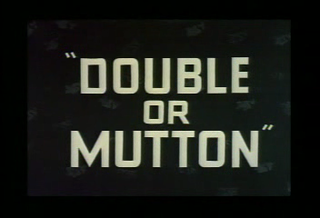
Bluto, at times known as Brutus, is a cartoon and comics character created in 1932 by Elzie Crisler Segar as a one-time character, named "Bluto the Terrible", in his Thimble Theatre comic strip. Bluto made his first appearance on September 12 of that year. Fleischer Studios adapted him the next year (1933) to be the main antagonist of their theatrical Popeye animated cartoon series.

Herr Meets Hare is a 1945 anti-Nazi Merrie Melodies cartoon directed by Friz Freleng. The short was released on January 13, 1945, and features Bugs Bunny. This short, released not long before the collapse of the Third Reich, was the penultimate wartime themed cartoon from Warner Bros. being released just under four months before Victory in Europe Day.

Cheese Chasers is a 1951 Warner Bros. Merrie Melodies cartoon directed by Chuck Jones and written by Michael Maltese. The cartoon was released on August 25, 1951 and stars Hubie and Bertie, with Claude Cat.

Scrap Happy Daffy is a 1943 Warner Bros. Looney Tunes short directed by Frank Tashlin. The cartoon was released on August 21, 1943, and stars Daffy Duck.
Satan's Waitin' is a 1954 Warner Bros. Looney Tunes cartoon directed by Friz Freleng. The short was released on August 7, 1954, and stars Tweety and Sylvester.
The Popeye Song Folio is a collection of 24 songs issued by Popular Melodies, Inc. 1619 Broadway, New York City in 1936. They contain the tunes played in the various Popeye cartoon short series directed by Dave Fleischer.

Kit for Cat is a 1948 Looney Tunes cartoon directed by Friz Freleng. The short was released on November 6, 1948 and features Elmer Fudd and Sylvester.

Plane Daffy is a 1944 Warner Bros. Looney Tunes cartoon directed by Frank Tashlin. The cartoon was released on September 16, 1944, and stars Daffy Duck.

Double or Mutton is a 1955 Warner Bros. Looney Tunes cartoon directed by Chuck Jones. The short was released on July 23, 1955, and is the third cartoon featuring Ralph Wolf and Sam Sheepdog.

Popeye the Sailor is an American animated series of short films based on the Popeye comic strip character created by E. C. Segar. In 1933, Max and Dave Fleischer's Fleischer Studios, based in New York City, adapted Segar's characters into a series of theatrical cartoon shorts for Paramount Pictures. The plotlines in the animated cartoons tended to be simpler than those presented in the comic strips, and the characters slightly different. A villain, usually Bluto, makes a move on Popeye's "sweetie", Olive Oyl. The villain clobbers Popeye until he eats spinach, giving him superhuman strength. Thus empowered, Popeye makes short work of the villain.

To Duck or Not to Duck is a 1943 Warner Bros. Looney Tunes cartoon directed by Chuck Jones. The cartoon was released on March 6, 1943, and stars Daffy Duck and Elmer Fudd.

You're a Sap, Mr. Jap is a 1942 one-reel anti-Japanese Popeye the Sailor animated cartoon short subject released by Paramount Pictures on August 7, 1942. It was the first cartoon short to be produced by Famous Studios. It is one of the best-known World War II propaganda cartoons.

Popeye the Sailor is a fictional cartoon character created by Elzie Crisler Segar. The character first appeared on January 17, 1929, in the daily King Features comic strip Thimble Theatre. The strip was in its tenth year when Popeye made his debut, but the one-eyed sailor quickly became the lead character, and Thimble Theatre became one of King Features' most popular properties during the 1930s. Following Segar's death in 1938, Thimble Theatre was continued by several writers and artists, most notably Segar's assistant Bud Sagendorf. The strip continues to appear in first-run installments on Sundays, written and drawn by R. K. Milholland. The daily strips are reprints of old Sagendorf stories.
Snow Excuse is a 1966 Warner Bros. Merrie Melodies cartoon directed by Robert McKimson. The short was released on May 21, 1966, and stars Daffy Duck and Speedy Gonzales.

Blow me Down! is a Popeye theatrical cartoon short in the Paramount Picture short series. It was released in 1933 and was the third cartoon in the Popeye the Sailor series of theatrical cartoons released by Paramount Pictures.

Seasin's Greetinks! is a Popeye theatrical Christmas-themed cartoon short, starring William "Billy" Costello as Popeye and Bonnie Poe as Olive Oyl and William Pennell as Bluto. It was released on December 17, 1933 and is in the Popeye the Sailor series of theatrical cartoons released by Paramount Pictures.

Let's You and Him Fight is a Popeye theatrical cartoon short released in February 16, 1934, starring William "Billy" Costello as Popeye, Bonnie Poe as Olive Oyl, William Pennell as Bluto and Charles Lawrence as the announcer.

Confusions of a Nutzy Spy is a 1943 Warner Bros. Looney Tunes cartoon directed by Norman McCabe. The short was released on January 23, 1943, and stars Porky Pig.

Dave Barry was an American actor. He is well known for his role as an actor in Playgirl, High Society, Voice in the Mirror, Some Like It Hot and How to Seduce a Woman.

Bosko's Store is a 1932 Warner Bros. Looney Tunes cartoon directed by Hugh Harman. It was released on August 13, 1932, and stars Bosko, the first star of the series. As is the case with most Looney Tunes of its time, it was directed by Hugh Harman and its music scored by Frank Marsales.

















